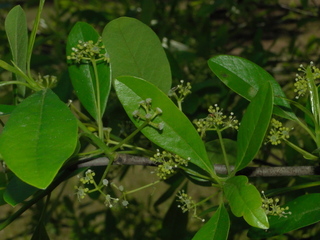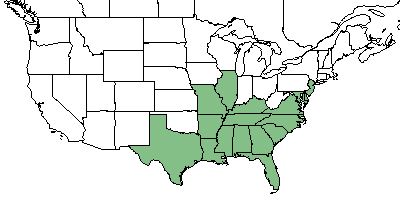Nyssa biflora
Common names: Swamp tupelo [1]
| Nyssa biflora | |
|---|---|

| |
| Photo by Bobby Hattaway at the Discover Life Database | |
| Scientific classification | |
| Kingdom: | Plantae |
| Division: | Magnoliophyta - Flowering plants |
| Class: | Magnoliopsida - Dicots |
| Order: | Cornales |
| Family: | Cornaceae |
| Genus: | Nyssa |
| Species: | N. biflora |
| Binomial name | |
| Nyssa biflora Walter | |

| |
| Natural range of Nyssa biflora from USDA NRCS Plants Database. | |
Contents
Taxonomic Notes
Synonym: N. sylvatica (Marshall)
Variety: none
Description
N. biflora is a perennial tree of the Cornaceae family that is native to North America. [1]
Distribution
N. biflora is found throughout the southeastern United States; specifically, Florida, Georgia, Alabama, South Carolina, North Carolina, Virginia, Maryland, Deleware, New Jersey, Tennessee, Kentucky, Mississippi, Louisiana, Texas, Arkansas, Missouri, and Illinois.[1]
Ecology
Habitat
Ideal soil for N. biflora is wet bottomland soils, such as mucks, heavy clays, and wet sands. Shallow moving water is ideal such as swamp banks, ponds, and estuaries. Practically full sunlight is necessary fro successful growth. [1]
Likely habitats include river swamps, depressions in pinelands, and pocosins.[2]
Nyssa biflora can be a predominant species in the natural habitats it is found in, particularly in pineland ponds. [3] It is commonly on the sandy, peaty shores of the ponds or swamps. [4]
Phenology
N. biflora has been observed flowering in March, April, and May, as well as in September and October.[5]
Seed dispersal
Seeds are dispersed by gravity and birds, some carried away by water. [1] Seeds can tolerate some competition when germinating. [1]
Use by animals
The White tail deer utilize the twigs and foliage. Small mammals and birds will eat the fruit. Also, birds and small mammals will make nests and cavities in the tree. The flowers provide nectar for bees. [1]
Diseases and parasites
The forest tent caterpillar will cause growth loss and mortality for N. biflora[1]
The tree can also develop lesions due to Fusarium solani. A variety of fi=ungi can cause heartrot. It is also prone to sapsucker. [1]
Conservation and Management
Regeneration is possible by clear cutting in preparation of a large seed fall.[1]
Controlling deer population is necessary for conserving N. biflora.[1]
It also can compete with loblolly and long-leaf pines for water and sun light which can hinder its growth. [1]
Cultivation and restoration
Photo Gallery
References and notes
- ↑ 1.00 1.01 1.02 1.03 1.04 1.05 1.06 1.07 1.08 1.09 1.10 1.11 USDA Plant Database
- ↑ Weakley, A. S. (2015). Flora of the Southern and Mid-Atlantic States. Chapel Hill, NC, University of North Carolina Herbarium.
- ↑ Hall, T. F. and W. T. Penfound (1943). "Cypress-gum communities in the blue girth swamp near Selma, Alabama." Ecology 24(2): 208-217.
- ↑ URL: http://herbarium.bio.fsu.edu. Last accessed: June 2018. Collectors: R. Kral, States and counties: Alabama (Covington), Florida (Gulf, Franklin), Georgia (Grady)
- ↑ Nelson, G. PanFlora: Plant data for the eastern United States with emphasis on the Southeastern Coastal Plains, Florida, and the Florida Panhandle. www.gilnelson.com/PanFlora/ Accessed: 24 MAY 2018